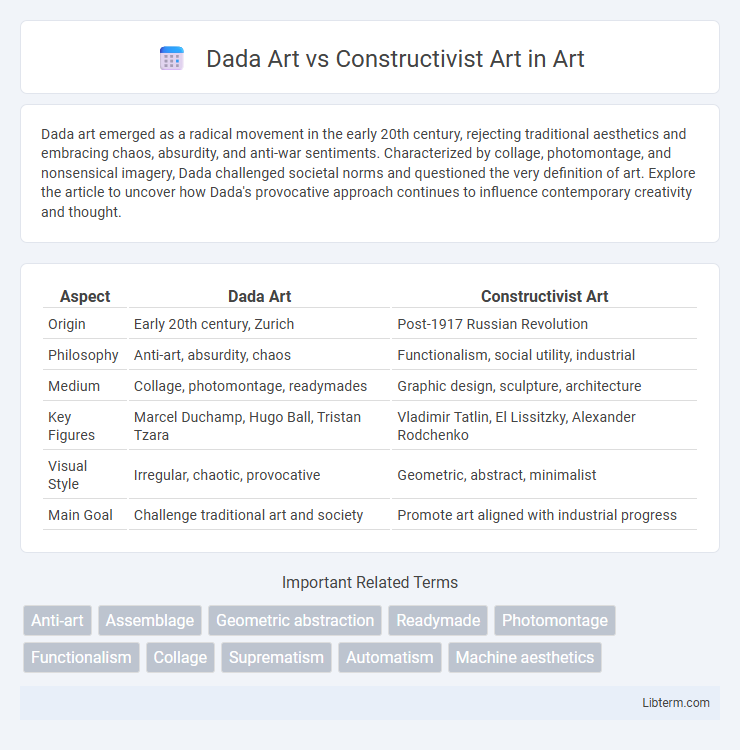Dada art emerged as a radical movement in the early 20th century, rejecting traditional aesthetics and embracing chaos, absurdity, and anti-war sentiments. Characterized by collage, photomontage, and nonsensical imagery, Dada challenged societal norms and questioned the very definition of art. Explore the article to uncover how Dada's provocative approach continues to influence contemporary creativity and thought.
Table of Comparison
| Aspect | Dada Art | Constructivist Art |
|---|---|---|
| Origin | Early 20th century, Zurich | Post-1917 Russian Revolution |
| Philosophy | Anti-art, absurdity, chaos | Functionalism, social utility, industrial |
| Medium | Collage, photomontage, readymades | Graphic design, sculpture, architecture |
| Key Figures | Marcel Duchamp, Hugo Ball, Tristan Tzara | Vladimir Tatlin, El Lissitzky, Alexander Rodchenko |
| Visual Style | Irregular, chaotic, provocative | Geometric, abstract, minimalist |
| Main Goal | Challenge traditional art and society | Promote art aligned with industrial progress |
Origins and Historical Context
Dada Art originated in Zurich during World War I as a response to the horrors and absurdity of war, emphasizing anti-art, spontaneity, and irrationality. Constructivist Art emerged in post-revolutionary Russia around 1913-1920, rooted in socialist ideals and focusing on practical art forms that supported industrial and social progress. Both movements reacted to political and social upheavals but diverged in purpose: Dada challenged traditional aesthetics through chaos and satire, while Constructivism promoted functional design and collective progress.
Key Philosophies and Aesthetic Goals
Dada Art challenges traditional art by embracing absurdity, anti-bourgeois sentiments, and spontaneous creativity, aiming to disrupt established cultural norms through irrationality and parody. Constructivist Art emphasizes functionalism, materiality, and socially purposeful design, promoting art as a tool for industrial progress and collective socialist ideals. Both movements reject conventional aesthetics, but Dada prioritizes chaos and subversion, while Constructivism focuses on order, utility, and ideological clarity.
Influential Artists and Major Figures
Dada Art was shaped by influential figures such as Marcel Duchamp, Hannah Hoch, and Tristan Tzara, who emphasized anti-art and absurdity to challenge traditional aesthetics. Constructivist Art was defined by artists like Vladimir Tatlin, Alexander Rodchenko, and El Lissitzky, who focused on geometric abstraction and practical design rooted in social and political ideology. These movements' pioneering artists significantly impacted modern art by introducing radical approaches to form, function, and meaning.
Characteristics of Dada Art
Dada Art is characterized by its anti-establishment ethos, embracing absurdity, spontaneity, and irrationality to challenge traditional artistic norms. It often employs collage, photomontage, ready-mades, and performance art to critique war, politics, and bourgeois culture. Emphasizing chaos and randomness, Dada works reject conventional aesthetics and celebrate absurd humor and subversion.
Characteristics of Constructivist Art
Constructivist Art emphasizes geometric shapes, industrial materials, and a focus on functionality, reflecting its roots in Soviet-era design and social purpose. It rejects decorative elements, prioritizing abstraction, precision, and the integration of art into everyday life and architecture. This movement contrasts with Dada Art's chaotic, anti-establishment nature by promoting order, technological progress, and collective utility.
Techniques and Materials Used
Dada art employs unconventional materials such as found objects, collage elements, and photomontage to challenge traditional aesthetics and convey anti-war sentiments. Constructivist art utilizes industrial materials like steel, glass, and plastic combined with geometric forms to emphasize functionalism and technological progress. Techniques in Dada prioritize spontaneity and absurdity, whereas Constructivism relies on precision and engineering principles to create socially utilitarian artworks.
Political and Social Influences
Dada Art emerged as a direct response to the horrors of World War I, using absurdity and anti-art techniques to critique bourgeois society and reject traditional cultural values. Constructivist Art, developed in post-revolutionary Soviet Russia, embraced industrial materials and geometric forms to promote socialist ideals, aiming to serve the proletariat and advance collective social progress. Both movements reflect their political climates: Dada's anarchic expressions challenge societal norms, while Constructivism aligns with state-driven goals of utilitarian art for social transformation.
Major Works and Iconic Examples
Dada Art is epitomized by Marcel Duchamp's "Fountain" (1917), a readymade sculpture challenging traditional art norms through everyday objects. Constructivist Art highlights Vladimir Tatlin's "Monument to the Third International" (1920), a visionary architectural model symbolizing industrial modernity and communist ideology. Both movements revolutionized artistic expression by rejecting classical aesthetics but diverged in purpose, with Dada embracing absurdity and Constructivism promoting functionalism.
Legacy and Influence on Contemporary Art
Dada Art challenged traditional aesthetics and inspired contemporary artists to embrace absurdity, spontaneity, and anti-establishment themes, fostering movements such as Neo-Dada and Pop Art. Constructivist Art's emphasis on geometric abstraction and functional design deeply influenced modern architecture, graphic design, and digital art, promoting the integration of art with technology and industry. Both movements significantly shaped the trajectory of contemporary art by encouraging experimentation and redefining art's role in society.
Dada vs Constructivism: Lasting Impact and Distinctions
Dada art challenged traditional aesthetics through irrationality and anti-art sentiments, leaving a lasting impact on contemporary art movements by inspiring experimental and conceptual approaches. Constructivist art emphasized functionalism and industrial materials, influencing modern architecture, design, and social art projects focused on utility and collective progress. The primary distinction lies in Dada's embrace of chaos and absurdity versus Constructivism's commitment to order, purpose, and technological advancement.
Dada Art Infographic

 libterm.com
libterm.com